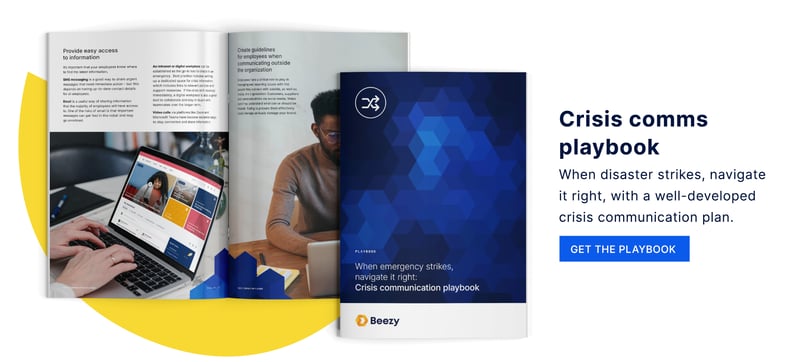
When a crisis hits, let your digital workplace come to the rescue
Beezy
September 15, 2021The Red Cross recently launched a campaign called ‘a crisis can happen at any time.’ Because the reality is that no one knows when the next crisis will strike – whether it’s a fast-spreading infectious disease, a data privacy breach, or a power crisis, like the one that hit the state of Texas earlier this year. In these situations, personal safety and family wellbeing are priority number one, but after that’s been assured, employees need to know if their organization can continue to operate.
Crisis communication is critical, and the need for it is on the rise. Without a plan in place, things can quickly get out of hand, and information from multiple sources can lead to misunderstandings, frustration, or even poor decisions. Those first 15 minutes after you learn of a crisis are just the beginning of what could be a very long haul, so leaders need to act fast and minimize chaos for employees.
If the worst does happen, focus on your communications and the messages you need to deliver. Crisis situations can result in shifts in your workplace while you try to navigate the best solution. Whether it’s technological, financial, natural, or any other hardship, a crisis could mean altering schedules, positions, projects, and even bigger changes that impact employee health and wellbeing.
How do you react to crises? How do your employees adapt and stay productive? What happens if your team isn’t in one place (as is most likely the case given remote and hybrid working)?
Discover our tips for delivering the most effective crisis communications in today’s hybrid work environments and the critical role your digital workplace can play in the event of an emergency.
How to lead through the storm: 5 tips for using your digital workplace
During a crisis, it can be hard to continue operations and productivity. People need time to deal with what’s happening and organizations need to prioritize transparency and think about business continuity. It’s key here to minimize the chaos first.
Aim to become the trusted voice in a crisis that your employees and organization turn to for the truth and solutions. Begin by building a culture that relies on the information in your digital workplace so that when a crisis hits, everyone knows where to get the most current and accurate updates.
In a remote and hybrid work environment, with employees spread out across different locations, a crisis can be hard to navigate.
Here are a few ways your digital workplace can help:
1. Make your digital workplace a key part of company culture
Hopefully, you’ll never have to put any of this to the test - but that doesn’t mean you shouldn’t be prepared. Start by setting up a dedicated space inside your digital workplace for crisis information, which includes links to relevant policies and other support resources. It’s vital that you make sure every single employee knows how to access this space, and that it’s the first place they should check if anything happens.
Encourage employees to think of your intranet or digital workplace as the go-to place for updates by posting regularly and asking them to do the same. The more you cement it in their minds as a singular source of truth, the more they’ll be willing to lean on it in the event of a crisis.
2. Make sure staff can access it at all times
Run regular access checks to test staff’s connection and make sure they’re able to log on at a moment’s notice. An effective digital workplace needs to be mobile accessible, so staff can join from anywhere in the world. After all, if there’s one thing you can guarantee people will grab in an emergency, it’s their phone.
It’s also a good idea to include information and training on your digital workplace in your onboarding process, so staff know where to go from day one.
3. Find out exactly where everyone is
Whether it’s a natural disaster or a random act of violence, ensuring that all your employees are safe should be your top priority. Having staff check in online or mark themselves as ‘safe’ on your digital workplace can help you do this as quickly as possible and keep a clear digital record of the process.
Once you know where everyone is, you can direct resources to the right places in order to locate missing employees. Teach your staff how to share their location and let them know that this is the first thing you need them to do if disaster strikes.
4. Take control of the situation with clear messaging
The last thing you want in the event of a crisis are confusing messages flying back and forth and adding to the panic. Take the lead by using your digital workplace’s broadcast features to push out all the information your staff need to respond safely and proactively. Tell them exactly what’s happened and exactly what’s expected of them.
Have a team start working on FAQs and update them as the situation evolves. As things develop, your staff will look to you for guidance and reassurance – so make sure to let them know what events mean for them.
5. Connect the right people
Encourage your staff to keep their contact info up to date and ask that they regularly add new skills and experiences to their employee profiles. This is not only useful for day-to-day operations but can save time in a crisis by allowing you to immediately see who has relevant expertise.
Use targeted messages to reach these people and connect them with other staff members to form response teams. The quicker you can set these up, the quicker they can begin to guide your organization back towards normal.
Next steps
Consider what happens not just today, but tomorrow and beyond. This may involve allocating dedicated resources that are freed up from the day-to-day pressures of managing the crisis.
Start by being proactive – reconsider policies if necessary or have a look at the Beezy crisis communication playbook and implement the right tools in your digital workplace today to ensure operational continuity. A long-term perspective on the crisis can help your organization emerge stronger and more sustainable.



